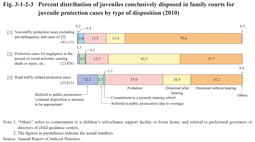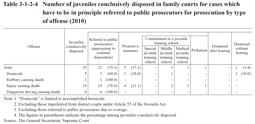2 Family courts
(1) Cases received
Fig. 3-1-2-2 shows the number of juveniles newly received by family courts for juvenile protection cases since 1949.
The number of juveniles received for non-traffic protection cases (refers to juvenile protection cases but excluding those pertaining to violations of road traffic related acts) reached a peak in 1966 and again in 1983, but then continued to decrease for a number of years. It remained at around 200,000, but was decreasing every year from 2004.
The number of juveniles received for road traffic related protection cases (refers to juvenile protection cases pertaining to violations of road traffic related acts) decreased sharply after the traffic infraction notification system was made applicable to juveniles in 1970 and its scope of application then expanded in 1987. The number was subsequently on a decreasing trend, even in recent years.
Fig. 3-1-2-2 Number of juveniles newly received by family courts for juvenile protection cases (1949-2010)
(2) Dispositions
a. Overview of conclusive dispositions
Fig. 3-1-2-3 shows the percent distribution of juveniles conclusively disposed in family courts for [1] non-traffic protection cases but excluding pre-delinquency and protection cases for negligence in the pursuit of social activities causing death or injury, etc. (cases of [2]), [2] protection cases for negligence in the pursuit of social activities causing death or injury, etc. (refers to juvenile protection cases for negligence in vehicle driving/negligence in the pursuit of social activities causing death or injury and dangerous driving causing death or injury), and [3] road traffic related protection cases by type of disposition in 2010. See Appendix 3-3 for the number of juveniles conclusively disposed by type of delinquency and type of disposition.
Fig. 3-1-2-3 Percent distribution of juveniles conclusively disposed in family courts for juvenile protection cases by type of disposition (2010)
b. Disposition of cases referred to public prosecutors for prosecution
Cases involving a juvenile aged 16 or older at the time of the offense resulting in death of the victim through an intentional criminal act, in principle, have to be referred to public prosecutors for prosecution. Table 3-1-2-4 shows the number of juveniles conclusively disposed in family courts involving those types of cases (but excluding cases where juveniles were referred to public prosecutors due to being overage) by type of offense in 2010.
During the period of April 1, 2001 through to the end of 2010, a total of 512 juveniles were conclusively disposed for those types of cases and 328 (64.1%) referred to public prosecutors for prosecution (Source: The General Secretariat, Supreme Court).
Table 3-1-2-4 Number of juveniles conclusively disposed in family courts for cases which have to be in principle referred to public prosecutors for prosecution by type of offense (2010)


